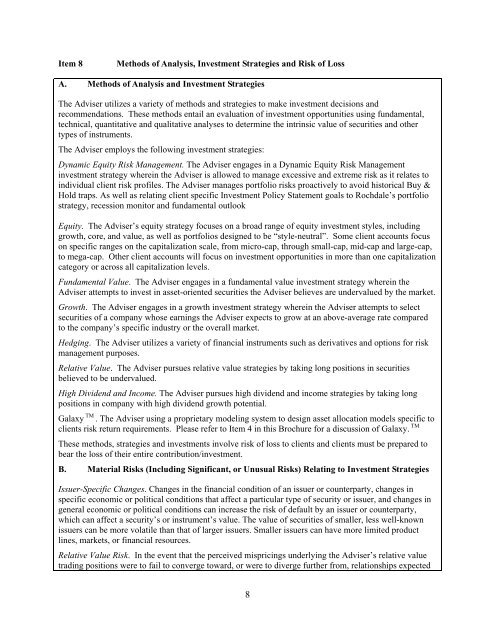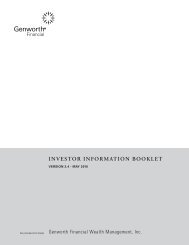Part 2A of Form ADV: Firm Brochure Item 1 Cover Page ROCHDALE ...
Part 2A of Form ADV: Firm Brochure Item 1 Cover Page ROCHDALE ...
Part 2A of Form ADV: Firm Brochure Item 1 Cover Page ROCHDALE ...
You also want an ePaper? Increase the reach of your titles
YUMPU automatically turns print PDFs into web optimized ePapers that Google loves.
<strong>Item</strong> 8<br />
Methods <strong>of</strong> Analysis, Investment Strategies and Risk <strong>of</strong> Loss<br />
A. Methods <strong>of</strong> Analysis and Investment Strategies<br />
The Adviser utilizes a variety <strong>of</strong> methods and strategies to make investment decisions and<br />
recommendations. These methods entail an evaluation <strong>of</strong> investment opportunities using fundamental,<br />
technical, quantitative and qualitative analyses to determine the intrinsic value <strong>of</strong> securities and other<br />
types <strong>of</strong> instruments.<br />
The Adviser employs the following investment strategies:<br />
Dynamic Equity Risk Management. The Adviser engages in a Dynamic Equity Risk Management<br />
investment strategy wherein the Adviser is allowed to manage excessive and extreme risk as it relates to<br />
individual client risk pr<strong>of</strong>iles. The Adviser manages portfolio risks proactively to avoid historical Buy &<br />
Hold traps. As well as relating client specific Investment Policy Statement goals to Rochdale’s portfolio<br />
strategy, recession monitor and fundamental outlook<br />
Equity. The Adviser’s equity strategy focuses on a broad range <strong>of</strong> equity investment styles, including<br />
growth, core, and value, as well as portfolios designed to be “style-neutral”. Some client accounts focus<br />
on specific ranges on the capitalization scale, from micro-cap, through small-cap, mid-cap and large-cap,<br />
to mega-cap. Other client accounts will focus on investment opportunities in more than one capitalization<br />
category or across all capitalization levels.<br />
Fundamental Value. The Adviser engages in a fundamental value investment strategy wherein the<br />
Adviser attempts to invest in asset-oriented securities the Adviser believes are undervalued by the market.<br />
Growth. The Adviser engages in a growth investment strategy wherein the Adviser attempts to select<br />
securities <strong>of</strong> a company whose earnings the Adviser expects to grow at an above-average rate compared<br />
to the company’s specific industry or the overall market.<br />
Hedging. The Adviser utilizes a variety <strong>of</strong> financial instruments such as derivatives and options for risk<br />
management purposes.<br />
Relative Value. The Adviser pursues relative value strategies by taking long positions in securities<br />
believed to be undervalued.<br />
High Dividend and Income. The Adviser pursues high dividend and income strategies by taking long<br />
positions in company with high dividend growth potential.<br />
Galaxy TM . The Adviser using a proprietary modeling system to design asset allocation models specific to<br />
clients risk return requirements. Please refer to <strong>Item</strong> 4 in this <strong>Brochure</strong> for a discussion <strong>of</strong> Galaxy. TM<br />
These methods, strategies and investments involve risk <strong>of</strong> loss to clients and clients must be prepared to<br />
bear the loss <strong>of</strong> their entire contribution/investment.<br />
B. Material Risks (Including Significant, or Unusual Risks) Relating to Investment Strategies<br />
Issuer-Specific Changes. Changes in the financial condition <strong>of</strong> an issuer or counterparty, changes in<br />
specific economic or political conditions that affect a particular type <strong>of</strong> security or issuer, and changes in<br />
general economic or political conditions can increase the risk <strong>of</strong> default by an issuer or counterparty,<br />
which can affect a security’s or instrument’s value. The value <strong>of</strong> securities <strong>of</strong> smaller, less well-known<br />
issuers can be more volatile than that <strong>of</strong> larger issuers. Smaller issuers can have more limited product<br />
lines, markets, or financial resources.<br />
Relative Value Risk. In the event that the perceived mispricings underlying the Adviser’s relative value<br />
trading positions were to fail to converge toward, or were to diverge further from, relationships expected<br />
8








